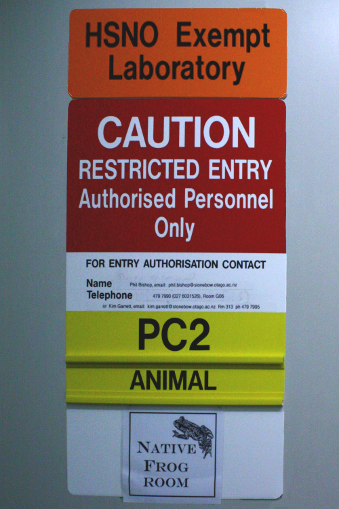Captive management is where animals are kept in captivity in some sort of enclosed space to assist survival of their species. This might be in a university lab, a zoo or a research centre. The individuals are closely monitored and are usually part of a conservation research project.
All our native reptiles and amphibians are protected under the Wildlife Act 1953. It is illegal to keep any of these species in captivity without a permit from the Department of Conservation (DOC). DOC only issues permits for captive management when there is a clear benefit for the species involved. Anyone applying for a permit must prove that they are experienced and able to provide appropriate captive conditions.
In New Zealand, a number of reptile and amphibian species are represented in captive populations. Two well known examples include the Hochstetter’s frogs at Hamilton Zoo and the tuatara at Victoria University of Wellington.
Benefits of captive management
In New Zealand, a large number of our native reptile species and all of our native frogs are endangered. The first course of action in conservation management is always to work with these species in their natural habitat. However, for many existing populations in New Zealand, it is not possible to remove mammalian predators, and these endangered species will always be at risk in the wild.
For some of these species, scientists have created captive management options.
Captive management has a number of benefits:
- Captive populations provide the opportunity for more in-depth study, which is not practical in the wild.
- Captive breeding programmes can provide individuals for translocation
- Captive individuals on display can help to raise public awareness about the importance of conservation.
The long-term goal for any captive management plan is always to restore or increase numbers of the species in the wild.
Problems with keeping animals in captivity
While there are many benefits to keeping animals in captivity, there can be significant negative effects on individual animals, for example, higher mortality. There are also risks to wild populations if the programme is poorly managed. For example, if a captive frog infected with chytrid fungus was translocated to a wild population, the results could be devastating.
A number of research projects in the past decade have made significant advances in improving animal husbandry for captive management in New Zealand. This includes a number of projects working with reptiles and amphibians. For example, Kelly Hare, a postdoctoral researcher at the University Of Otago, is investigating which captive management regimes result in the healthiest individuals for future translocations. She works with a common species of skink in order to inform work with more endangered species.
Factors that need to be considered to maintain healthy captive populations include temperature, humidity, watering, diet, lighting, handling, housing and treatment of disease. The Department of Conservation publishes documents with advice on the most appropriate husbandry techniques. These documents are developed in collaboration with scientists working in this research area.
Related content
Meet three scientists who are actively involved in reptile and amphibian conservation research:
- Phil Bishop is passionate about frogs and talks about his research into frog disease. Find out more about his tailor-made frog tanning salons, built to treat a bone disease affecting our native frogs.
- Alison Cree was involved in the establishment of Orokonui Ecosanctuary near Dunedin. Find out how this mainland island and Alison’s research may enable tuatara to return to the South Island.
- Kelly Hare is interested in which captive management regimes result in the healthiest individuals for future translocations. Discover why she spends time chasing skinks down a reptile racetrack.
Activity ideas
Create a lizard-friendly habitat provides students with ideas on how to attract skinks and geckos to the school grounds.
Ethics in conservation science encourages students to consider the conservation of native frogs from a number of different perspectives.
Frogs for the future? is a ready-to-use cross-curricular teaching resource. It uses the Connected article Kimihia Kermit as the starting point.
In addition, this activity investigates the regulations and ethics involved with keeping earthworms in the classroom, it can be easily adapted for other species.
Useful link
Visit the NZFrogs website to find out more frongs in New Zealand.

